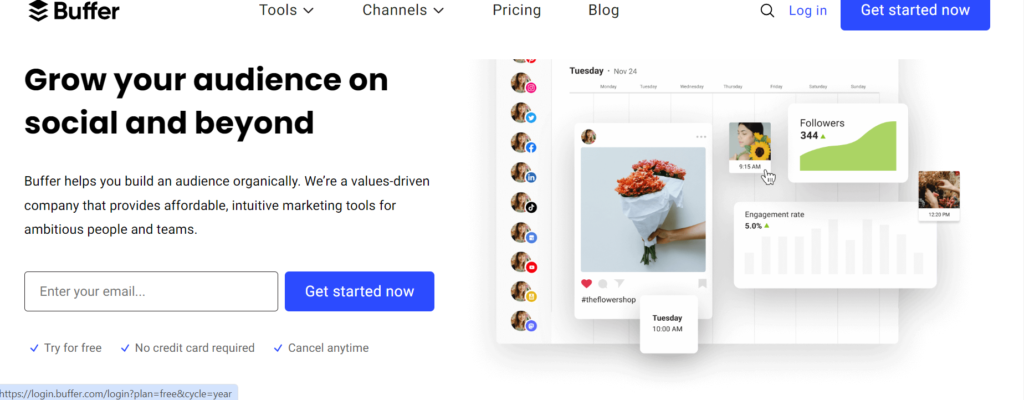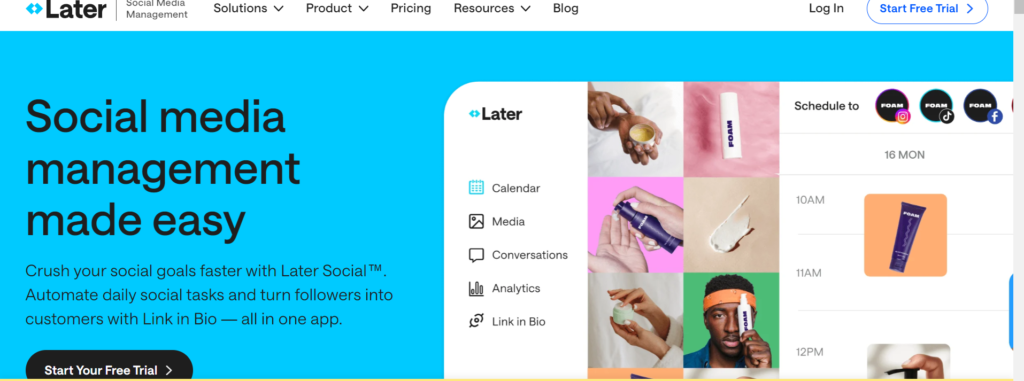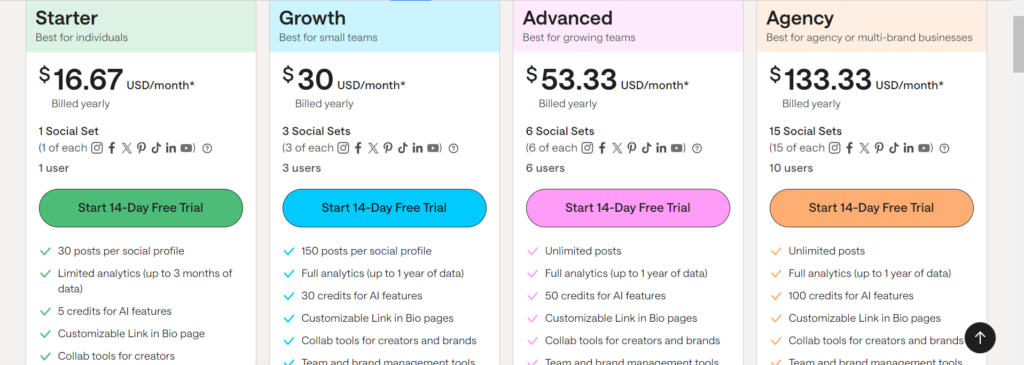Intro:
In the dynamic landscape of digital marketing, there is best 5 social media marketing tools, social media remains an indispensable avenue for businesses to connect with their audiences, build brand awareness, and drive engagement. As we step into 2024, the importance of effective social media marketing tools cannot be overstated. These tools not only streamline the management of multiple social media platforms but also provide insights crucial for crafting impactful campaigns. Here, we present a curated list of the five best social media marketing tools for 2024, each offering unique features and functionalities tailored to meet the diverse needs of modern marketers. From scheduling posts to analyzing performance metrics and fostering collaboration, these tools empower businesses to navigate the ever-evolving social media landscape with confidence and precision. Let’s delve into the realm of social media marketing excellence with our top picks for the year ahead.
What is the 5 best social media marketing tools
here’s some information about each of the tools listed and the criteria used to select them:
- Hootsuite: Hootsuite is a comprehensive social media management platform that allows users to schedule posts, engage with their audience, and analyze their social media performance across multiple platforms from one dashboard. It supports integration with a wide range of social media platforms including Facebook, Twitter, Instagram, LinkedIn, Pinterest, and YouTube. Hootsuite was selected for its extensive features, user-friendly interface, and wide range of integrations, making it suitable for businesses of all sizes looking to manage their social media presence effectively.
- Buffer: Buffer is a social media management tool that enables users to schedule posts, analyze performance, and manage multiple social media accounts in one place. It offers a clean and intuitive interface, making it easy for users to schedule posts at optimal times for maximum engagement. Buffer also provides detailed analytics to help users track the success of their social media campaigns. It was selected for its simplicity, affordability, and effectiveness in scheduling and analyzing social media content.
- Sprout Social: Sprout Social is a robust social media management and analytics platform that provides a range of features including scheduling, monitoring, engagement, and analytics. It offers advanced features such as social listening and reporting, allowing businesses to better understand their audience and track the success of their social media efforts. Sprout Social was selected for its comprehensive feature set, advanced analytics, and reputation for providing excellent customer support.
- Later: Later is a social media scheduling tool that is particularly popular among Instagram users. It allows users to visually plan and schedule posts, as well as analyze performance and track hashtags. Later also offers tools for user-generated content curation and Instagram Stories scheduling. It was selected for its focus on visual content, ease of use, and popularity among Instagram users.
- Canva: Canva is an online graphic design platform that offers a wide range of tools and templates for creating visually appealing graphics and social media content. While not specifically a social media management tool, Canva is an invaluable resource for businesses looking to create professional-looking graphics for their social media posts. It was selected for its user-friendly interface, vast library of templates and design elements, and affordability.
The criteria used to select these tools included their features and functionality, user-friendliness, reputation, customer reviews, integration with popular social media platforms, and affordability. These tools were chosen based on their ability to help businesses streamline their social media marketing efforts, save time, and effectively engage with their audience across multiple platforms.
1. Hootsuite

Description: Hootsuite is a comprehensive social media management platform designed to simplify and streamline the process of managing multiple social media accounts. It offers a range of features including scheduling posts, monitoring conversations, engaging with followers, and analyzing performance metrics. With support for a wide variety of social media platforms including Facebook, Twitter, Instagram, LinkedIn, Pinterest, and YouTube, Hootsuite provides users with a centralized dashboard from which they can manage all of their social media activities.
Pros:
- Multi-platform support: Hootsuite allows users to manage multiple social media accounts from one dashboard, saving time and effort.
- Scheduling capabilities: Users can schedule posts in advance, ensuring consistent and timely content delivery.
- Social listening: Hootsuite offers social listening features that enable users to monitor conversations and mentions across social media platforms, helping them stay informed about their brand’s online presence.
- Analytics and reporting: The platform provides detailed analytics and reporting tools to track the performance of social media campaigns and identify areas for improvement.
- Collaboration features: Hootsuite offers collaboration tools that allow teams to work together on social media campaigns, assign tasks, and streamline communication.
Cons:
- Learning curve: While Hootsuite offers a wide range of features, it can have a steep learning curve for new users, particularly those who are unfamiliar with social media management platforms.
- Pricing: Hootsuite’s pricing plans can be relatively expensive for small businesses or individuals, particularly if they require access to advanced features.
- Limited customer support: Some users have reported issues with Hootsuite’s customer support, including slow response times and limited availability.
Price:

Hootsuite offers a range of pricing plans to suit different needs and budgets. The pricing starts at $99 per month for the Professional plan, which includes support for 10 social profiles, one user, and basic analytics. The Team plan starts at $249 per month and includes support for 20 social profiles, three users, and additional features such as advanced analytics and team collaboration tools. Custom pricing is available for larger organizations with specific requirements.
Experience: Overall, my experience with Hootsuite has been positive. The platform’s comprehensive feature set has helped me effectively manage multiple social media accounts, schedule posts, monitor conversations, and track performance metrics. While there is a learning curve involved in mastering the platform, the benefits of centralized social media management and detailed analytics make it worth the investment. However, I have occasionally encountered issues with customer support, and the pricing can be a barrier for smaller businesses or individuals with limited budgets. Nonetheless, Hootsuite remains a popular choice for businesses looking to streamline their social media marketing efforts and improve their online presence.
2.Buffer

Description:
Buffer is a social media management platform that simplifies the process of scheduling and publishing content across various social media platforms. It provides users with tools to plan and schedule posts, analyze performance metrics, and engage with their audience. Buffer supports popular social media platforms including Facebook, Twitter, Instagram, LinkedIn, and Pinterest, making it a versatile solution for businesses and individuals looking to manage their social media presence effectively.
Pros:
- User-friendly interface: Buffer offers an intuitive and easy-to-use interface, making it accessible to users of all skill levels.
- Scheduling capabilities: Users can schedule posts in advance across multiple social media platforms, allowing for consistent and timely content delivery.
- Analytics and insights: Buffer provides detailed analytics and insights to track the performance of social media campaigns and identify trends and areas for improvement.
- Collaboration features: The platform offers collaboration tools that allow teams to work together on social media campaigns, assign tasks, and streamline communication.
- Browser extension: Buffer offers a browser extension that enables users to easily share content from the web directly to their social media profiles, saving time and effort.
Cons:
- Limited features: Compared to some other social media management platforms, Buffer may have fewer advanced features and capabilities.
- Pricing: While Buffer offers a free plan with limited features, its paid plans can be relatively expensive for businesses or individuals with limited budgets.
- Limited social media platform support: While Buffer supports popular social media platforms, it may not offer support for some niche or emerging platforms.
Price:

Buffer offers a range of pricing plans to suit different needs and budgets. The pricing starts at $0 per month for the Free plan, which includes support for three social accounts, 10 scheduled posts per profile, and basic analytics. The Pro plan starts at $6 per month and includes support for eight social accounts, 100 scheduled posts per profile, and additional features such as advanced analytics and social media calendar. The Business plan starts at $12 per month and includes support for 25 social accounts, 2,000 scheduled posts per profile, and features such as team collaboration and social media reporting.
Experience: Overall, my experience with Buffer has been positive. The platform’s user-friendly interface and scheduling capabilities have helped me streamline my social media management tasks and maintain a consistent posting schedule across multiple platforms. The analytics and insights provided by Buffer have also been valuable in tracking the success of my social media campaigns and identifying areas for improvement. However, the pricing of Buffer’s paid plans can be a deterrent for some users, and the platform may lack some advanced features offered by competitors. Nonetheless, Buffer remains a popular choice for businesses and individuals looking for a simple and effective social media management solution.
Description: Sprout Social is a comprehensive social media management platform designed to help businesses manage their social media presence effectively. It offers a range of features including scheduling and publishing content, monitoring conversations, engaging with followers, and analyzing performance metrics. Sprout Social supports integration with popular social media platforms such as Facebook, Twitter, Instagram, LinkedIn, Pinterest, and YouTube, providing users with a centralized dashboard to manage all of their social media activities.
3.Sprout Social

Pros:
- Advanced features: Sprout Social offers a wide range of advanced features including social listening, sentiment analysis, and competitor analysis, allowing businesses to gain deeper insights into their audience and competitors.
- User-friendly interface: The platform features an intuitive and easy-to-navigate interface, making it accessible to users of all skill levels.
- Collaboration tools: Sprout Social offers collaboration tools that enable teams to work together on social media campaigns, assign tasks, and streamline communication.
- Analytics and reporting: The platform provides detailed analytics and reporting tools to track the performance of social media campaigns, measure ROI, and identify trends and opportunities for improvement.
- Excellent customer support: Sprout Social is known for its excellent customer support, with responsive customer service representatives available to assist users with any issues or questions.
Cons:
- Pricing: Sprout Social’s pricing plans can be relatively expensive compared to some other social media management platforms, particularly for small businesses or individuals with limited budgets.
- Learning curve: While Sprout Social offers a wide range of features, it may have a steeper learning curve for new users, particularly those who are unfamiliar with social media management platforms.
- Limited support for smaller social media platforms: While Sprout Social supports integration with popular social media platforms, it may not offer support for some smaller or niche platforms.
Price:

Sprout Social offers a range of pricing plans to suit different needs and budgets. The pricing starts at $199 per user per month for the Standard plan, which includes support for five social profiles, basic analytics, and reporting. The Professional plan starts at $299 per user per month and includes support for 10 social profiles, advanced analytics, and additional features such as social listening and automation. The Advanced plan starts at $399 per user per month and includes support for 10 social profiles, advanced analytics, and features such as custom workflows and audience targeting.
Experience:
Overall, my experience with Sprout Social has been positive. The platform’s advanced features, intuitive interface, and excellent customer support have helped me effectively manage my social media presence and track the success of my social media campaigns. While the pricing of Sprout Social’s plans may be a barrier for some users, particularly smaller businesses or individuals with limited budgets, the platform offers a comprehensive suite of tools and features that make it a valuable asset for businesses looking to maximize their social media marketing efforts.
4.Later

Description: Later is a social media scheduling tool that is particularly popular among Instagram users, although it supports other platforms like Facebook, Twitter, and Pinterest. It allows users to visually plan and schedule posts, analyze performance metrics, and curate user-generated content. Later’s focus on visual content makes it an ideal choice for businesses and individuals looking to maintain an engaging and consistent presence on social media platforms.
Pros:
- Visual planning: Later offers a visual planning interface that allows users to see how their Instagram feed will look once posts are published, helping to maintain a cohesive aesthetic.
- Instagram-focused features: Later offers a range of features specifically designed for Instagram, such as Instagram Stories scheduling, hashtag suggestions, and user-generated content curation.
- Easy scheduling: The platform’s user-friendly interface makes it easy to schedule posts in advance, ensuring consistent and timely content delivery.
- Analytics and insights: Later provides detailed analytics and insights to track the performance of social media campaigns and identify trends and opportunities for improvement.
- Free plan available: Later offers a free plan with basic features, making it accessible to individuals and small businesses with limited budgets.
Cons:
- Limited features for non-Instagram platforms: While Later offers robust features for Instagram, its support for other platforms like Facebook, Twitter, and Pinterest may be more limited in comparison.
- Pricing for advanced features: While Later offers a free plan with basic features, its paid plans can be relatively expensive for businesses or individuals with specific needs, such as advanced analytics or team collaboration tools.
Price:

Later offers a range of pricing plans to suit different needs and budgets. The pricing starts at $16.67 per month for the Free plan, which includes support for one social profile per platform, 30 posts per profile per month, and basic analytics. The Plus plan starts at $30 per month and includes support for one social profile per platform, 150 posts per profile per month, and additional features such as advanced analytics and social media calendar. The Premium plan starts at $53.33 per month and includes support for three social profiles per platform, unlimited posts per profile per month, and features such as team collaboration and Instagram Stories scheduling. the agency is 133.33
Experience:
Overall, my experience with Later has been positive. The platform’s visual planning interface and Instagram-focused features have helped me maintain a cohesive and engaging presence on social media. While the pricing of Later’s paid plans may be a deterrent for some users, particularly those with specific needs or limited budgets, the platform offers a range of features that make it a valuable tool for businesses and individuals looking to maximize their social media marketing efforts, particularly on Instagram.
5.Canva

Description:
Canva is an online graphic design platform that offers a wide range of tools and templates for creating visually appealing graphics and social media content. It provides users with an intuitive drag-and-drop interface, making it easy to create professional-looking designs without the need for graphic design expertise. Canva’s extensive library of templates, graphics, and design elements allows users to customize their designs to suit their specific needs and preferences.
Pros:
- User-friendly interface: Canva offers an intuitive and easy-to-use interface, making it accessible to users of all skill levels.
- Extensive library of templates and graphics: The platform provides users with access to a vast library of templates, graphics, and design elements, allowing them to create professional-looking designs quickly and easily.
- Customization options: Canva offers a wide range of customization options, including the ability to adjust colors, fonts, and layout, ensuring that users can create designs that reflect their brand identity.
- Collaboration features: Canva offers collaboration tools that allow teams to work together on designs, share feedback, and streamline the design process.
- Affordable pricing: Canva offers a free plan with basic features, making it accessible to individuals and small businesses with limited budgets. The platform also offers paid plans with additional features such as access to premium templates and advanced design tools.
Cons:
- Limited functionality for complex designs: While Canva is suitable for creating simple and straightforward designs, it may lack some of the advanced functionality offered by professional graphic design software.
- Branding limitations: The free version of Canva may have limitations on branding options, such as the ability to upload custom fonts or remove Canva’s watermark from designs.
Price:

Canva offers a range of pricing plans to suit different needs and budgets. The pricing starts at $0 per month for the Free plan, which includes access to basic design tools and templates. The Pro plan starts at $12.99 per month and includes additional features such as access to premium templates, advanced design tools, and the ability to upload custom fonts and remove Canva’s watermark from designs. Canva also offers Enterprise plans for larger organizations with specific requirements.
Experience: Overall, my experience with Canva has been highly positive. The platform’s user-friendly interface, extensive library of templates and graphics, and affordability make it an invaluable resource for creating visually appealing social media content and graphics. While Canva may not offer the same level of functionality as professional graphic design software, it provides more than enough features for most users to create stunning designs quickly and easily. The collaboration features have also been useful for working with team members on design projects. Overall, I highly recommend Canva to anyone looking to create professional-looking designs for social media and beyond.



